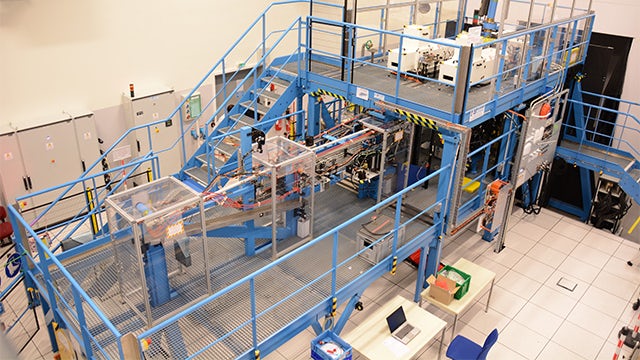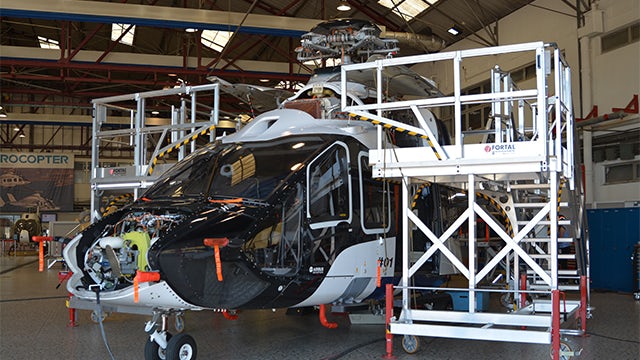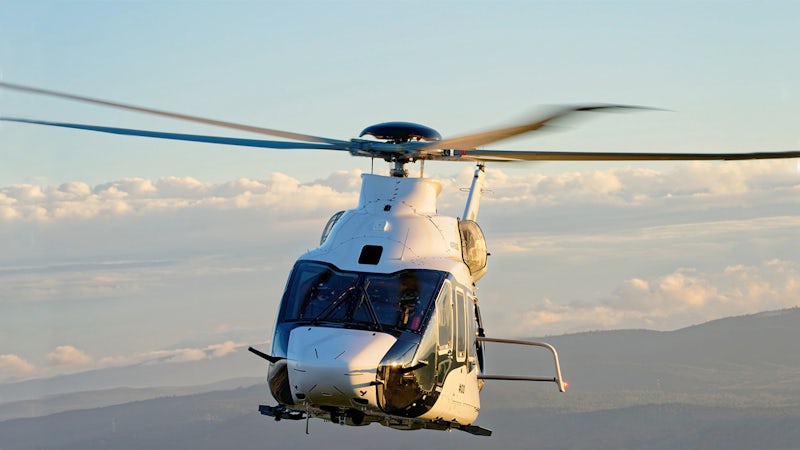Simcenter Amesim and Simcenter Engineering help manufacturer reduce fuel system design cycle by a year
Siemens Digital Industries Software solution enables Airbus Helicopters to enhance model management and traceability
Airbus Helicopters
Airbus Helicopters is a division of the Airbus Group, a world leader in aerospace and defense-related services.
http://www.airbus-group.com- Headquarters:
- Marignane, France
- Products:
- Simcenter Products, Simcenter Amesim
- Industry Sector:
- Aerospace & defense
After three months of joint work with the Simcenter Engineering and Consulting team aimed at defining a step-by-step real-time methodology to achieve desired performance, the fuel specialists have been convinced and the decision has been made to extend this approach to all fuel models.
Airbus Helicopters
In 1993, NHIndustries, a joint venture between Airbus, Leonardo Helicopters and Fokker Aerostructures, started to design the NH90, a heavy military helicopter. Thirteen years later, it entered into service.
Today, the competition has become so fierce that helicopter manufacturers usually have no more than four years to develop their most sophisticated models.
The pace of technological change has markedly increased. As a result, manufacturers must make the right choices when designing increasingly complex systems. They have to validate systems integration earlier in the development process by applying a collaborative modeling approach throughout the design cycle.
In addition, rotorcraft manufacturers must provide their customers with reliable pilot training solutions. However, flight simulators must often be delivered before the first helicopter is produced. The level D full flight simulator (FFS), which is the current standard with comprehensive high-fidelity aerodynamic and systems modeling, is increasingly being requested, most recently for the Airbus Helicopters H160, a new medium-sized twin engine helicopter.

Figure 5: The unique Simcenter Amesim model can be adapted for system design, controls validation, simulators and test rigs.
Investing in simulation
Airbus Helicopters, part of the Airbus Group, is Europe‘s leading fully integrated aeronautical company, known for its high-performing, cost-effective, safe and comfortable helicopters, such as the H160.
To maintain its leadership position, the company has invested in virtual testing to meet many needs along the development cycle, such as rapid prototyping, desktop simulation, real-time pilot-in-the loop simulation, test rig development and training solutions. Airbus Helicopters’ simulation policy stipulates that, if possible, a unique model should be used for each component throughout the V-cycle. To apply this simulation approach to physical system modeling, Airbus Helicopters needed a tool that was highly predictable and could be used to easily integrate models into the real-time environment. The company found such a tool in Simcenter Amesim™ software from product lifecycle management (PLM) specialist Siemens Digital Industries Software.
Reducing hydraulic system prototype costs
Airbus Helicopters has used Simcenter Amesim for hydraulic and air conditioning system simulation since 2007. In 2009, the company extended the use of Simcenter Amesim to thermo-hydraulic component and system modeling.
Prior to adopting Simcenter Amesim, specialists in the hydraulic and flight controls department at Airbus Helicopters were only able to obtain a quasi-static representation of the hydraulic system. The majority of parameters were determined during the prototype testing phase. Moreover, these hydraulics models were incompatible with a broader co-simulation environment. To take into account the behavior of the hydraulic circuit in realtime simulation, Airbus Helicopters previously built another model using a specification that a hydraulics specialist had prepared for a supplier. However, those simulations had not been predictive and required the involvement of the hydraulic engineer. The use of Simcenter Amesim enabled hydraulics design engineers to move from a quasi-static to a dynamic world. Now, not only can they model hydraulic systems and subsystems, such as pumps, actuators and tanks, they can also use the same model to gain insight into the systems’ behavior when interacting with thermal, mechanical or electrical systems. “By using Simcenter Amesim for the hydraulic system design, we estimate that we have reduced optimization time by a factor of three, and prototype costs by a factor of four,” explains Thibaut Marger, former analysis and simulation specialist in the hydraulic and flight controls department at Airbus Helicopters Research and Development. “The first prototype that we manufacture is to fine-tune the Simcenter Amesim model. The system optimization is performed virtually. That leads to the creation of a new prototype that is very close to optimizing performance.”

Figure 1: The pilot project is aimed at validating the simulation approach in the H160 in order to reduce the fuel system test cycles by a factor of two for the next helicopter models
Providing top-notch services
Siemens Digital Industries Software has also helped Airbus Helicopters find a solution to carry out real-time simulation, which supports system engineering as well as test rig and full flight simulator design. Thanks to its experience in methodology development, Simcenter Engineering and Consulting services provided Airbus Helicopters with best-in-class support to convert hydraulic circuit plant models built using Simcenter Amesim into real-time compatible models. These models were then used on Airbus Helicopters’ unique real-time simulation platform for the development of the Airbus Helicopter H175. First, Simcenter Engineering and Consulting analyzed the computer processing unit (CPU) time required by existing hydraulics models, and helped Airbus Helicopters optimize its models, taking into account potential dysfunctions, such as a broken hydraulic pump, actuator leakage or inadvertent back-up pump activation. Next, the company used a unique model so it could understand the thermal dynamic behavior of the system for many scenarios. Finally, the model was reduced in order to keep only the phenomena that are compatible with the real-time, fixed step solver frequency.
Using several standard Simcenter Amesim libraries, capabilities and tools made this project feasible. These included the Simcenter Amesim Hydraulics library, the Simcenter Amesim Hydraulic Component Design library, the Simcenter Amesim Signal, Control library and the Simcenter Amesim Mechanical library; and super component functionality, activity index, linear analysis performance analyzer tools.
Reducing flight test hours by half
Following the successful use of Simcenter Amesim for hydraulic system design and validation, the company decided to launch a benchmark project aimed at extending this simulation approach to the fuel system. The integration of the fuel system into the H160 had been mainly validated during intensive test rig sessions and flight tests. Even though the H160 was nearing entry into service, the goal of this pilot project was to validate this simulation approach for future helicopter models, and enable Airbus Helicopters to reduce the fuel system test cycles by a factor of two.
Moreover, there had been room for improving design processes: earlier on, in addition to the physical model developed by fuel specialists, a real-time model had been developed by integration specialists that provided input on the fuel system’s macroscopic behavior to other components. Without continuous collaboration between the two groups, it was difficult to efficiently address complex engineering challenges, such as: valve and pipe sizing, the design of complexly-shaped fuel tanks, fuel transfer analysis that depended on the attitude and accelerations of the helicopter, and physical fluid characteristics analysis that depended on environmental conditions such as temperature or pressure.
It was also critical to validate the location of fuel gauges to precisely estimate the fuel remaining in each tank (throughout various mission types, and as a function of helicopter attitude) and facilitate the integration of the fuel system with the avionics, and thus to be able to reliably inform the crew on the remaining mission time.
“Using thermal, hydraulic, mechanical and fuel equipment capabilities of Simcenter Amesim, we can create a model that enables us to accurately predict the fuel system’s behavior,” says Stéphane Amerio, simulation engineer at Airbus Helicopters. “It would be too costly and dangerous to carry out this analysis on real test benches.”
“I provide information to the design office in order to fine-tune the simulation model and continuously improve our way of working,” says Nicolas Certain, flight test engineer at Airbus Helicopters. “Not only does simulation enable us to reduce test cycles, it also allows us to focus on major issues related to the flight performance.”
“Simcenter Amesim enabled integration specialists to create easily understandable models that can be shared within our organization,” explains Franck Nicolas, head of simulation and tools at Airbus Helicopters. “The unique model can be adapted to our analysis goal, and can be used for system design, controls validation, simulators and test rigs.”
Adapting to customer needs
This benchmark project has enabled Airbus Helicopters to build a predictive model and validate it by comparing simulation and test results.
“This new approach is being used on new innovative concepts during the design phase and has enabled us to reduce the fuel system design phase by 12 months and the integration phase by nine months,” states Franck Nicolas. “After three months of joint work with the Simcenter Engineering and Consulting team aimed at defining a stepby-step real-time methodology to achieve desired performance, the specialists in fuel simulation have been convinced and the decision has been made to extend this approach to all real-time fuel models.”
This project has resulted in Airbus Helicopters identifying new opportunities to enhance its simulation process. Since the same model is re-used and refined throughout the design cycle, development specialists are now interested not only in the performance of their system, but also in the way it interacts with other systems. It allows them to assess the system performance under different conditions and modes as well as to anticipate undesirable behavior in the system prior to it being integrated into a helicopter.
“Being able to anticipate a problem is a significant source of cost and risk reduction,” says Nicolas Damiani, expert in simulation expert within the simulation department of the Engineering directorate. at Airbus Helicopters Research and Development. “This approach allows us to master the development cycle and delivery time as well as to reduce our risk exposure related to the fuel development and integration activities that we usually face in such programs.”
Airbus Helicopters is studying the possibility of extending this process to other systems, and this approach is attracting interest from other from other Airbus entities.
“The use of Simcenter Amesim is part of a broader model- and simulation-based systems engineering approach aimed at detecting specification and design errors early in the design cycle,” says Pascal Paper, model-based systems engineering (MBSE) method and tools stream leader at Airbus Helicopters. “Model-based systems engineering is a key enabler of requirements validation, knowledge capitalization and multidisciplinary collaboration within Airbus entities.”
Simcenter Amesim enabled integration specialists to create easily understandable models that can be shared within our organization. The unique model can be adapted to our analysis goal, and can be used for system design, controls validation, simulators and test rigs.
Airbus Helicopters
